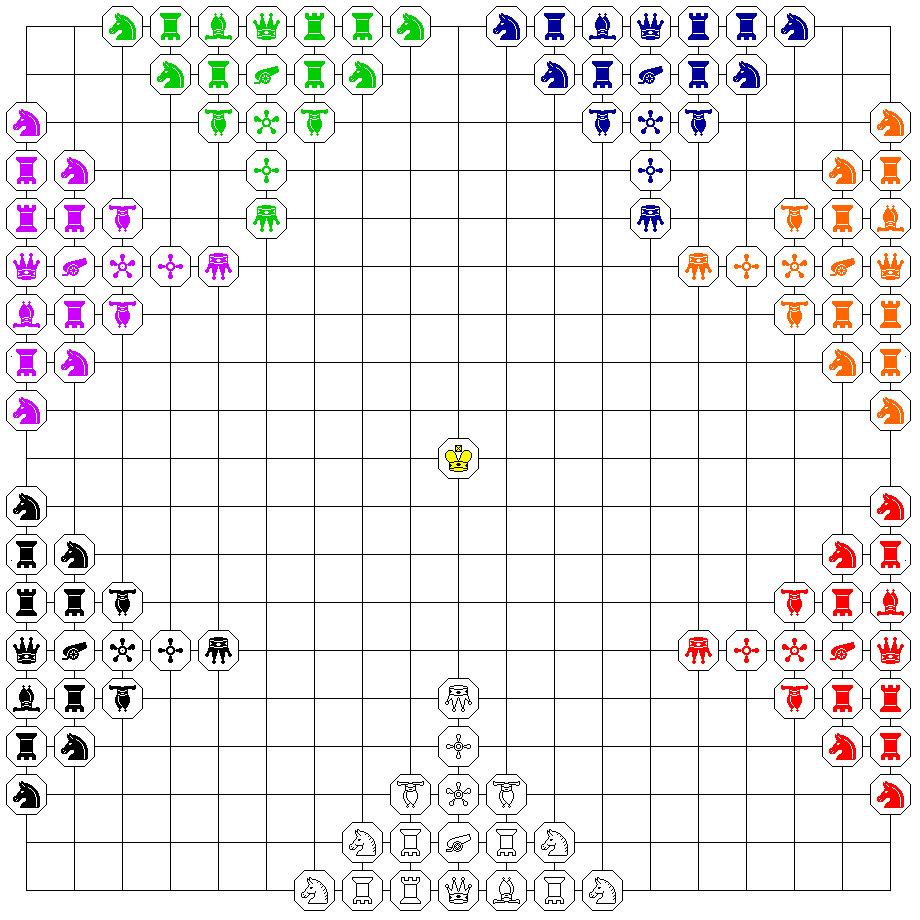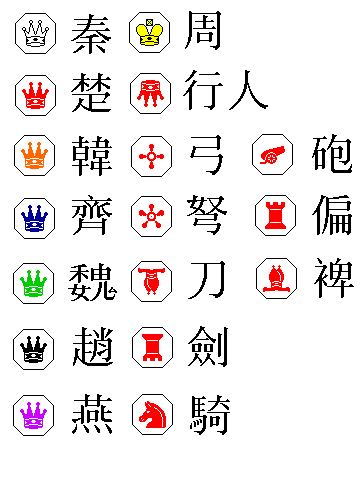
Although a seven-player game on a somewhat asymmetrical board is of limited interest in itself, this game was convenient to draw, and thus I went ahead and documented it here, thanks to information from another web site:

Each player's fifth row consists of a Diplomat, which moves like a Queen, but which cannot capture or give check, or be captured.
The fourth row consists of an archer which moves exactly four spaces, either diagonally or orthogonally.
The third row consists of Swordsman, Crossbowman, and Swordsman. The Swordsman moves one space diagonally. The Crossbowman moves exactly five spaces on each turn, either diagonally or orthogonally.
The second row consists of Cavalry, Broadswordsman, Cannon, Broadswordsman, and Cavalry. The Cavalry piece moves one space orthogonally and then changes course 45 degrees to move three spaces diagonally. The Broadswordsman moves one space orthogonally. The Cannon moves as in regular Chinese Chess: it moves like a Rook, but captures on Rook lines by leaping over an intervening piece, whether enemy or allied, and then landing on the square of the piece captured.
The first row consists of Cavalry, Broadswordsman, Lieutenant-General, General, Major, Broadswordsman, and Cavalry. The Cavalry and Broadswordsman move as above. The Lieutentant-General moves as the Rook, the General moves as the Queen, and the Major moves as the Bishop.
A piece representing the Emperor of the Zhou dynasty sits in the center of the board, and is immobile and cannot be captured.
One of the sides is defeated when either at least 11 of its pieces, or its General, is captured. Then its remaining pieces are removed from the board. A player wins when he captures either two Generals or 30 other pieces.
The order of moves is counter-clockwise; the side with the white pieces, shown at the bottom of the board (representing the compass direction West) moves first. The sides are:
As the number of players is reduced, first the player who plays the white pieces (for Qin), then also the player who plays the red pieces (for Chu), and then also the player who plays the indigo pieces (for Qi) also takes control of one other team of pieces.
The Chinese characters found on the pieces are shown in the image below:

Each piece usually has the same character, regardless of color, except for the General, which bears the name of the Warring State the troops of which he leads.

The map on the right shows how this same historical period might be represented in terms of a modern wargame. Because the same colors are used as in this chess variation, and not all of them contrast strongly, the counters for Qi (Ch'i) and Han are shown rotated by 45 degrees, so that they can be easily distinguished from those of Yan and Chu respectively.
Historically, it was Qi, or Ch'i, that won in the year 221 B.C., and this is why the country is called China in English today, as a consequence of its rule by the Ch'in Dynasty which began through the unification of China by the Ch'i forces.
The invention of this game is attributed to Kuang Si-Ma, a minister in the Song Dynasty, who is also the author of a treatise on government. As well, an anecdote about how he, as a child, rescued another child who fell into a cistern and was in danger of drowning had long been used as part of teaching Chinese schoolchildren to read. He is credited as the author of a description of this game from which we know of it, but the description is likely to have been one of a pre-existing game.
In addition to this game being played on the board used for Wei Ch'i (or Go), Kuang Si-Ma is connected to the game of Go in yet another way. In one of his poems, the phrase "reverberations from colliding jades" is used; the Japanese translation of that phrase, Kogyoku Yoin was used as the title for a Japanese book featuring 100 of the games played by one of the greatest Go players of all time, Honinbo Shusaku. A more recent book covering the games of Shusaku, Invincible: The Games of Shusaku, published by Kiseido Publishing, has been called the best (advanced) book on Go available in English.
Note that in a game with more than two players, an exact balance of forces is less important, since two players may choose to both attack one other player.
For two players, I might suggest either removing the white pieces from the board, or leaving them immobile and unused, and having one player play Chu, Qi, and Zhao, while the other player plays Han, Wei, and Yan. This would lead to a symmetrical layout, with equal forces for both players.